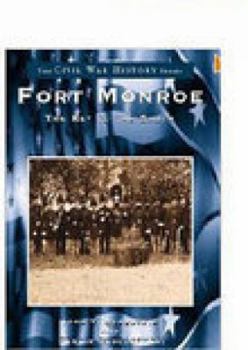Fort Monroe: The Key to the South
(Part of the Civil War History Series)
Select Format
Select Condition 
Book Overview
Fort Monroe: The Key to the South is a powerful pictorial portraying the exciting history of the only fort in the Upper South to remain under Union control throughout the Civil War. Strategically located on Old Point Comfort guarding the entrance to Hampton Roads and dominating the lower Chesapeake Bay, Fort Monroe quickly became a Federal bastion within the Confederacy and influenced many of the Civil War's greatest events. Known as "Freedom's Fortress" following Ben Butler's May 1861 decision to consider slaves escaping into Union lines as "contraband of war," Fort Monroe quickly became a symbol of freedom and helped to define the wartime objective to end slavery. Soldiers on Fort Monroe's ramparts witnessed first-hand several new technologies, including the first balloon launching to observe enemy operations and the first battle between ironclad warships. Fort Monroe also played a critical role in the eventual Union victory, serving as a base for amphibious operations against Southern ports as well as staging campaigns against the nearby Confederate capital in Richmond. The drama played along the parapets of Fort Monroe during the Civil War has been brought to life by this comprehensive visual history. Fort Monroe: The Key to the South features over 175 images documenting this massive fort and its role in pivotal events like the 1862 Peninsula Campaign, Monitor-Virginia (Merrimack) engagement, and the Hampton Roads Peace Conference. Whether views of famous men like Robert E. Lee, Abraham Lincoln, and Jefferson Davis or scenes of the many soldiers and civilians serving on Old Point Comfort, this pictorial vividly chronicles Fort Monroe's tremendous Civil War heritage.
Format:Paperback
Language:English
ISBN:073850114X
ISBN13:9780738501147
Release Date:December 1999
Publisher:Arcadia Publishing (SC)
Length:128 Pages
Weight:0.70 lbs.
Dimensions:0.3" x 6.3" x 9.5"
Customer Reviews
1 rating
Great work by a great historian of Virginia and the Civil War
Published by Thriftbooks.com User , 19 years ago
I have met Mr John Quarstein several times and I find him to be the most intriguing historian of our area in Virginia. He can now be seen on PBS and the History Channel and his knowledge of the Hampton Roads area and the Civil War are impressive. I recommend this book to anyone interested in Civil War history and the history of the Virginia Peninsula going back to the earliest times of Capt John Smith, Pocahontas, and the founding of Jamestown in 1607. "Fort Monroe, The Key to the South" is absolutely packed full of timeless information, maps and photos of a particularly important strategic spit of land that Capt John Smith called an "Isle fit for a Castle". Located off the coast of Hampton and Newport News Virginia, Old Point Comfort was immediately recognized for its strategic importance. Several forts were built on Old Point Comfort in the earliest times of American history (when America was still a colony of England) but were destroyed by the Dutch or fell into disrepair. As late as the War of 1812 there were still no useful defensive fortifications on Old Point Comfort. Congress finally acted and the construction of Fort Monroe (and a strategic man made Island initially called Fort Calhoun, later Fort Wool but commonly known as the "Rip-Raps" across the James River) was commenced in March of 1819. Fort Monroe (named after President James Monroe) was the dominant staging ground for Union Forces in the Battle of the Virginia Peninsula and witness (and participant) to the Battle of the Ironclads. Its importance was indisputable to Union forces. After the Civil War, Fort Monroe was Jefferson Davis' prison and has served the US Army until just recently. The BRAC commission called for it to be closed and developement plans for the Fort are in the works. Mr Quarstein, more than just writing about Fort Monroe (of which he loves) is working with a group of local leaders considering how to use the land. In this writer's opinion, Old Point Comfort and Fort Monroe are in good hands.





